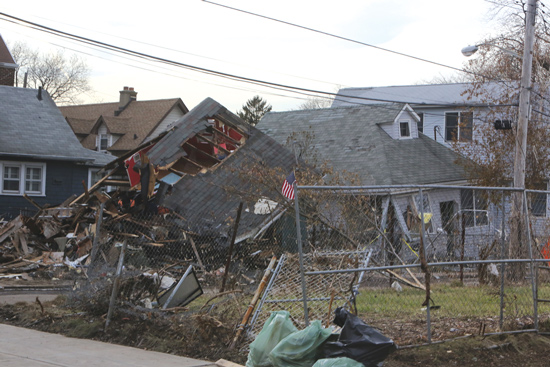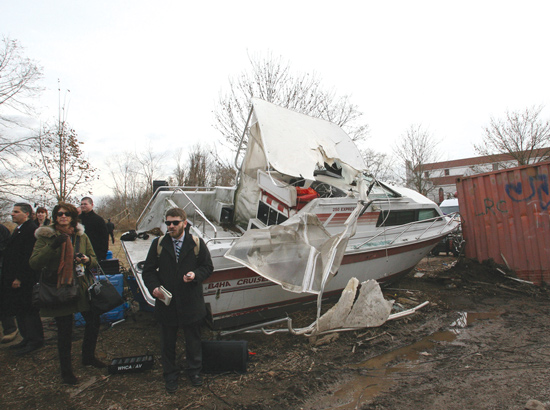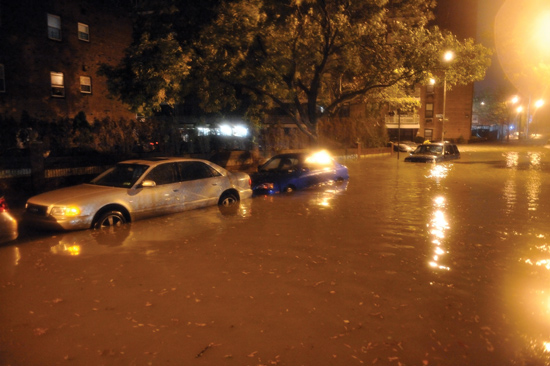
This topic appeared in the June 2012 issue of TLC magazine in my article titled: Flood damage: ARE you covered? After the devastating storm Sandy that hit the NY area this month, I am reprinting it under a new title:
FLOOD DAMAGE: WERE YOU COVERED?
Floods can even hit in low-risk areas — WERE you covered?
BYALAN PLAFKER, PRESIDENT & CEO
MEMBER BROKERAGE SERVICE LLC
A MELROSE CREDIT UNION SERVICE ORGANIZATION
Floods can even hit in low risk areas—make sure you’re covered.
If your car is washed away in a flood its loss likely will be covered by your auto policy. But, did you know that if your home is damaged in the same flood it won’t be covered by your homeowners insurance? This expensive fact has become a good deal more relevant in recent years with heavy rainfall causing record flooding in the Northeast. These events remind us that you don’t have to live in a high risk flood plain to be vulnerable to flooding.
Flooding, according to the Federal Emergency Management Agency, is the most common natural disaster in the United States. Floods in the U.S. cause more than $2 billion in property damage annually. Surprisingly, approximately 25 percent of all NFIP claims are made by people in low to moderate risk areas.
You should know before it’s too late—flood damage is not covered under a standard homeowners, farm owners or
business owners policy. In fact, nearly all insurance policies specifically exclude damages from flooding. Fortunately, flood insurance is available through the federal government’s National Flood Insurance Program and some specialty programs.

Hurricane Sandy storm damage in Staten Island.
© All rights reserved by governorandrewcuomo - Flickr photostream
Flood Facts:
The NFIP. As long as your locality participates in the program, NFIP coverage can be purchased through your agency today! They can help you explore your options.
Separate coverages apply to buildings and contents. Coverage up to $250,000 is available for residential buildings, and up to $100,000 for contents. Coverage for farm buildings and other nonresidential buildings, as well as separate coverage for their contents, are available in limits of up to $500,000. Both property owners and renters are eligible for this coverage. All policies are subject to exclusions.
What this year could bring. Most financial services literature features the disclaimer: “Past performance is no guarantee of future results.” The weather is like that, too. Yet, it’s hard to ignore the flurry of exceptional weather disasters in recent years.
Just in 2011 we had countless tornadoes across the Midwest and the South; we had 100 year floods along the Mississippi; we had hurricanes Irene and Lee which brought extreme flooding across the Northeast—flooding from which many are still recovering. Meanwhile, floods can happen anytime, for any number of reasons: heavy rainfall, a broken dam or reservoir near your home, burst water mains, etc.
You cannot plan for a flood. You can only know that should it happen to you it could devastate your home, your family and everything you’ve worked so hard to acquire. Take steps to protect yourself. Let your agent help.

Hurricane Sandy storm damage in Staten Island.
© All rights reserved by governorandrewcuomo - Flickr photostream
What is a Flood?
Anywhere it rains, it can flood. Many conditions can result in a flood:
A flood is a general and temporary condition where two or more acres of normally dry land or two or more properties are inundated by water or mudflow from one of the following:
Is my home insured for damage that may result from flooding caused by a hurricane or other storm?
Not necessarily. Generally, coverage provided by a standard home or business policy does not include damage caused by flooding or mudslides. It is important to note this type of damage could be extremely destructive to your property and without insurance you could be devastated financially.
How can I get insurance coverage so I’m protected for flood damage from a natural disaster?
First, contact your insurance agency. They have access to comprehensive information and can help you determine if you need flood insurance. Throughout the United States, more than 20,000 communities participate in the Federal Emergency Management Agency’s National Flood Insurance Program which offers flood insurance. An NFIP policy typically includes coverage for:
How much protection can I get?
You can obtain flood coverage up to $250,000 on your home, $100,000 on its contents and $500,000 for businesses.
Can I buy flood insurance at any time?
Yes, but in most cases there is a 30 day waiting period between the time flood insurance is purchased and the time coverage is in force.
How can I prepare for a catastrophe such as flooding?
Along with obtaining flood insurance protection you should heed storm warnings and follow evacuation procedures such as boarding up windows and storing outside items inside; shutting off utilities; and preparing an emergency kit that contains food and water, a portable can opener, clothing, blankets, flashlights, first aid supplies and a battery operated radio.
Also, maintain a current household or business inventory of your property and possessions and keep it in a safe place such as a safe deposit box. An up to date inventory will prove useful when filing your insurance claim.
Call your insurance agent now for a Flood Insurance quote. It is usually inexpensive & affordable. Remember, it usually takes 30 days for coverage to be effective so don’t delay. Insure your future. Start planning NOW before it is too late!
For more information talk to your financial professional, legal advisor, or the author of this article.
INSURANCE AND SAFETY STEPS AFTER A CATASTROPHIC EVENT?
Questions homeowners may have about their property loss claim following a catastrophic event
When a catastrophic event occurs, you no doubt will feel overwhelmed by the loss and the confusion that follows. Advance preparation is your first prescription for getting through the experience. But, now that you have suffered a loss, you will benefit from the kind of information that proceeds from questions asked by others who have endured similar events.
What is the most important thing to do first?
Your safety always is the most important concern. Do not return to your property until authorities have signaled it is safe to do so. When you approach the property, look for unsafe conditions such as downed power lines, the smell of natural gas and unstable structural conditions. If it is safe to proceed proactively shut off the utilities (electricity, natural gas, water, etc.) before inspecting the damage. Do not drink tap water without boiling it for five minutes first until you know the water is safe to drink.
Should I take pictures of the damage?
Yes. Take a liberal amount of pictures from different angles before you make emergency repairs to protect the property from further damage. You may use a video/digital camera for this purpose as well.
My home is too damaged to reside in. What do I do?
Contact your relatives, friends and church affiliates to see if they may be able to accommodate you temporarily. You may also want to seek help from the Federal Emergency Management Agency, the Red Cross, the Salvation Army or any other disaster recovery service organization.
Your homeowners policy, typically, will pay your additional
living expenses to reside at another location until repairs to your home can be completed. The typical homeowners policy covers events, such as fire, windstorm and tornado. Unfortunately, even if you have a flood insurance policy, your additional living expenses will not be paid when the damages are caused by flooding. Keep this in mind when you make your living arrangements.
What can I expect the adjuster to do when he or she arrives?
The adjuster will “scope” the damage, an important part of the claim process. An attempt will be made to determine the cause of damage, for example, was the damage caused by wind, flood or both? Next, the adjuster will itemize the property that has been damaged. You will want to make sure that nothing is overlooked.
The placement of values on the damaged property will not occur at this time. Appraisals, repair estimates and inventories will be obtained later to establish values. Often the adjuster will offer an advance payment on a covered claim so that restoration may begin and living arrangements can be made. Be sure to keep detailed records on how this money is spent.
Should I hire my own adjuster to assist me with my claim?
Public adjusters are paid a fee by the property owner based upon a percentage of the claim settlement, typically, between 10 and 15 percent (state laws may apply). Consequently, you will need to decide whether the adjuster’s services are worth the discounting of your claim settlement.
Some of the services public adjusters provide are:
Our agency will help you with coverage issues and provide assistance in the claim process. If your property values are out of the ordinary or the sheer volume of inventory is burdensome to you you may want the assistance of a public adjuster.
What if I do not agree with the property values upon which the insurance company is basing the loss amount?
It may just be a need for additional documentation. When you obtain the evidence that substantiates the property value go back to the adjuster and negotiate a better settlement. If the adjuster is being obstinate and unfair you can request to talk to the supervising adjuster. Our agency, as will other Independent Insurance Agents, will advocate on your behalf to the extent possible.
If you are unable to negotiate further with the adjuster there is an “Appraisal” provision in your policy that specifies a procedure for resolving differences in the valuation of property losses. You and the insurance company each will get an appraiser at their own expense. Then those two appraisers will choose an umpire whose fee is shared by the property owner and the insurance company. An agreement by any two of the three appraisers will establish the amount payable. Any time you feel your insurance company is not treating you fairly you may file a complaint with the Insurance Department.
HURRICANE SANDY
DFS (Department of Financial Services):
1. New York,
2. Bronx,
3. Kings,
4. Richmond,
5. Queens,
6. Nassau,
7. Suffolk,
8. Westchester,
9. Rockland, and
10. Orange.
The governor previously announced hurricane deductibles will not apply in most downstate homeowners insurance policies because the National Weather Service determined Sandy did not have sustained hurricane force winds when it hit New York. Keep in mind, however, that non-hurricane (windstorm) deductibles may still apply as per individual policy provisions. Ask your agent for more information on this.
Homeowners with both homeowners and flood insurance should follow FEMA rules to preserve their claims under flood insurance.
For homeowners insurance claims, if dwelling debris must be removed before the adjuster is able to examine it,
homeowners should:
This process applies to all contents that are damaged and will be claimed.

Corner of Brigham St. and Shore Pkwy., Brooklyn, NY - October 29, 2012
Anton Oparin / Shutterstock.com
Federal assistance available for storm victims
The Federal Emergency Management Agency announced that federal disaster aid has been made available to the state of New York and ordered federal aid to supplement state and local recovery efforts in the area affected by Sandy beginning on Oct. 27, 2012, and continuing.
Federal funding is available to affected individuals in Bronx, Kings, Nassau, New York, Queens, Richmond, Rockland, Suffolk and Westchester counties.
Grant to hire recovery workers. Additionally, New York State received $27.7 million in federal Disaster National Emergency Grant funds. The grant will be used to hire workers who lost their jobs as a direct result of Sandy in Bronx, Kings, New York, Richmond, Queens, Nassau, Suffolk, Rockland and Westchester counties to help clean up impacted communities.
“This federal grant will provide funds to hire much needed extra workers to help clean up and recover communities impacted by Hurricane Sandy and put unemployed New Yorkers back to work,” said Gov. Andrew Cuomo.
To be eligible workers must be unemployed as a result of Sandy or unemployed and not receiving unemployment
benefits or other types of income support.
Workers interested in this program should call (888) 469-7365. The New York State Department of Labor will work with local officials to recruit and hire workers.
DMV extensions. Gov. Cuomo announced extensions for state Department of Motor Vehicles renewal deadlines for all driver licenses, learner permits, nondriver ID cards and vehicle registrations. He announced, as well, extensions for certain state Department of Taxation and Finance tax filing and
payment deadlines for taxpayers directly affected by the storm in response to emergency conditions resulting from Sandy.
Please refer to pages 21-23 for assistance in applying for City, State and FEMA disaster relief. This relief is directed particularly to TLC industry members.
Your Professional Insurance Agent …
We want you to know about the insurance you’re buying.
Alan Plafker, CPIA is President of Member Brokerage Service LLC, a Melrose Credit Union Service Organization. He is a Certified Professional Insurance Agent and licensed Insurance Broker. He serves as First Vice President on the Board of Directors the PIANY (Professional Insurance Agents Association of NY), serves on the Board of CIBGNY (Council of Insurance Brokers of Greater NY), and serves as Treasurer for the New York Independent Livery Driver Benefit Fund Board of Directors. His Agency insures thousands of polices for TLC Insurance as well as many policies for all types of insurance. You can reach him in his Briarwood, Queens office at (718) 523-1300 Ext. 1082, or visit the website at: www.MemberBrokerage.com